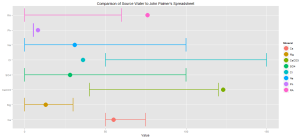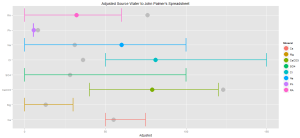Down The Rabbit Hole of Water Adjustments
Where I got started on this subject
This all started when I saw a blog post on Practical and Low Cost Water Adjustments. The author there is pretty convincing on the importance of this. Following links from that site, I found this. “Rerun” claims to live “just inside of Clermont County, about a mile east of Beechmont Ford”. I happen to live 5 miles east of Beechmont Ford. Our water in Clermont County comes from three sources and goes into a common distribution system (in other words, they’re all connected).
Coming Brew Day
I eat a lot of Mexican food (well, perhaps “Mexican inspired and styled American food”), and I know that two styles seem to work best: Amber Ale and Vienna Lager. I decided to go with a lager since my fermentation chamber is going to become a keezer. I happen to also see a traditional Vienna Lager on Five Blades Brewing’s website.
Due to availability, I had to substitute Carafa II for the Blackprinz,and carapils for carafoam (there is a lengthy discussion on the difference here). I also added and extra half of a pound of Vienna to compensate for the slightly lower efficiency of my system.
Looking at my source water compared to what John Palmer’s spreadsheet says to use, I’m in range for most of the minerals except for being low on chloride and high on hardness (both calcium carbonate and residual alkalinity).
Water Adjustments
I got John Palmer’s water spreadsheet from the BrewLab kit website. It’s an older version, an updated one is on the How To Brew website. The spreadsheet is fairly easy to use – select a style (from the 2008 styles, not a big deal, really), input my source water info (the boxes are YELLOW), input my RA (I used 0) and my strike water (3.53 gallons). I skipped dilution (left the rate at 0%). The next parts – mineral additions, acid, and results all work together – I looked at where I wasn’t in the range – which was only chloride, and added a gram of a mineral that provides chloride. That mineral is canning salt (NaCl, sodium chloride), so after adding a gram I noticed I was near the middle of the chloride range without exceeding the sodium range (up to 100 ppm). I also saw that total alkalinity was too high (by a measly 3 ppm), but that kept the residual alkalinity up high (76 compared to 0-60) which appears to cause the beer to be darker than expected (and this is expected, as I think all my beers have been darker than I planned). I added a milliliter of 88% lactic acid which reduced the total alkalinity to the middle of the range and the color to 7 – 14 SRM (the target is 10-16, the beer as planned is 10.4 SRM).
Finally, I went down to step 8, which is sparge water treatment. I’m sparging with 6 gallons, so I input the recommended 4 ml of lactic acid for my sparge water.
In the end, 1 gram of canning salt (pure sodium chloride) and 1 ml of lactic acid to the strike water, and 4 ml of lactic acid to the sparge water.
I’m typing this on Saturday night and I brew on Sunday. We’ll see how this works out.
Cheers!

